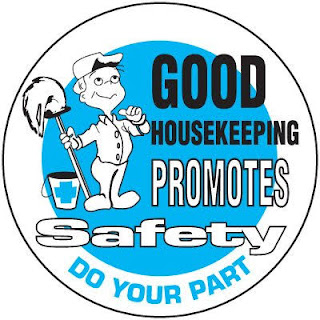Good Housekeeping Cleaning Tips
Plan a good housekeeping program-
A a a good housekeeping program plans and manages the orderly storage and movement of materials from point of entry to exit. It includes a material flow plan to ensure minimum handling. The plan also and shows that work areas are not used as storage area by having workers move materials to and from work areas as needed
The cost of this investment could be offset by the elimination of repeated handling of the same material and more effective use of the workers time. Often, ineffective or insufficient storage planning results in materials being handled and stored in hazardous waste. Knowing the plant layout and the moment of materials throughout the workplace can help plan work procedure.
Worker training is an essential part of any good housekeeping program workers need to know how to work safely with the products they use. They also need to know how to protect other workers such as by posting signs (e.g., "Wet - Slippery Floors") and reporting any unusual conditions.
Housekeeping order is "maintained" not "achieved". Cleaning and Organisation must be done regularly, not just at the end of the shift. Integrating housekeeping into jobs can help ensure this is done. A good housekeeping program identifies and assigns responsibility for the following :
- Clean up during the ship
- Day to day clean up
- Waste disposal
- Removal of unused materials
- Inspection to ensure clean up is complete.
Do not forget out-of-the-way places such as shelves, basements, shedes and boiler rooms that would otherwise be overlooked. The orderly arrangement of operations, tools, equipment and supplies is an important part of a good housekeeping program.
The final addition to any housekeeping program is inspection. It is the only way to check for deficiencies in the program so that changes can be made. The documents on workplace inspection checklist provided a general guides and examples of checklist for inspecting offices and manufacturing facilities.
Dust and Dirt Removals-
In some jobs, enclosures and exhaust ventilation systems may fail to collect dust, dirt and chips adequately. Vacuum cleaners are suitable for removing light dust and dirt. Industrial models have specific fittings for cleaning walls, ceilings, ledges, machineries, and other hard to reach place where dust and dirt may accumulate.
Special propose vacuum are useful for removing hazardous substance. For example, vacuum cleaners fitted with HEPA (high efficiency particular air) filters may be used to capture fine particles of asbestos or fiberglass.
Dampening waiting floors are using sweeping compounds before sleeping reduce the amount of airborne dust. The dust and grime that collect in places like shelves, piping, conduits, light fixtures, reflectors, windows, cupboards and lockers may require manual cleaning.
Compressor should not be used for removing dust, dirt for chips from equipment for work surfaces.



It is actually a great and helpful piece of information. we provide residential cleaning Toronto at affordable cost. to know more visit our website.
ReplyDelete